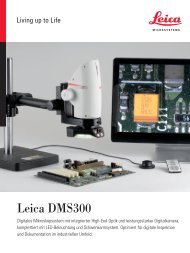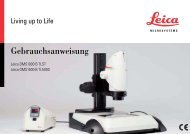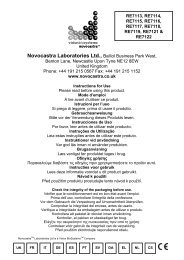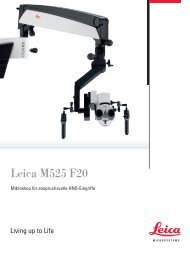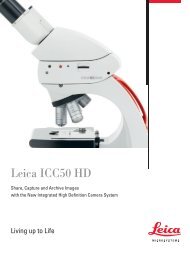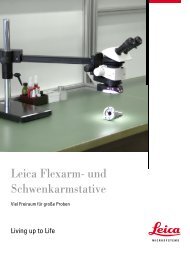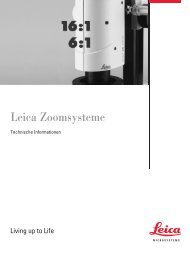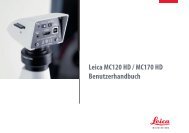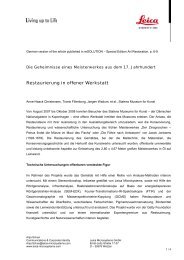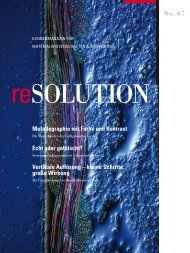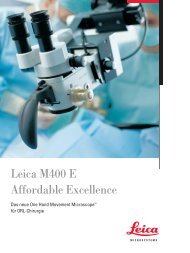Leica M720 OH5 - Leica Microsystems
Leica M720 OH5 - Leica Microsystems
Leica M720 OH5 - Leica Microsystems
Create successful ePaper yourself
Turn your PDF publications into a flip-book with our unique Google optimized e-Paper software.
<strong>Leica</strong> <strong>M720</strong> <strong>OH5</strong> a paradigm shift in vision, comfort, and flexibility<br />
9<br />
<strong>Leica</strong> <strong>M720</strong> <strong>OH5</strong><br />
Unsurpassed Patient Safety<br />
Dual independent light sources [1]:<br />
The <strong>Leica</strong> <strong>M720</strong> <strong>OH5</strong> features two completely<br />
independent 400 W xenon arc-lamp illumination<br />
systems, giving the surgeon confidence to know<br />
that surgery will not be jeopardized due to lamp or<br />
board failure.<br />
The <strong>Leica</strong> <strong>M720</strong> <strong>OH5</strong> offers innovative illumination solutions<br />
to improve outcomes for both the surgeon and the patient.<br />
Fast system reboot: If the power cable becomes<br />
disconnected for any reason, the system reboots in<br />
the fastest reset time available today.<br />
Illumination Setting<br />
Illumination Setting<br />
Intuitive user controls [2]: The graphical user<br />
interface and hard keys allow the user to<br />
conveniently and intuitively control all microscope<br />
functions during surgery.<br />
Max. illumination<br />
Max. illumination<br />
(BrightCare Plus<br />
inactive)<br />
Microscope with<br />
BrightCare Plus<br />
activated<br />
Conventional<br />
microscope at low<br />
magnification<br />
Conventional<br />
microscope at high<br />
magnification<br />
<strong>Leica</strong> Microscope<br />
with AutoIris <br />
Independent microscope controls: Stand, video,<br />
light, and microscope controls work independently.<br />
For example, should the video system fail, surgery<br />
can continue because the light and microscope are<br />
unaffected.<br />
Antimicrobial surface coating [3]: <strong>Leica</strong>’s<br />
AgProtect limits user exposure to surface<br />
pathogens. This nano silver coating covers the<br />
microscope’s outside surfaces and penetrates the<br />
membranes of microbes to prevent replication.<br />
Long working<br />
distance.<br />
Decreased working<br />
distance at<br />
same illumination<br />
setting (left)<br />
creates burn<br />
potential in<br />
conventional<br />
microscopes.<br />
BrightCare Plus<br />
automatically<br />
adapts light<br />
intensity to the<br />
working distance,<br />
providing safer<br />
illumination (up<br />
to 60% reduction<br />
of intensity).<br />
At low magnification,<br />
the field of<br />
illumination (yellow)<br />
fills the field<br />
of view (green)<br />
completely.<br />
Previously, as<br />
magnification<br />
increased, the<br />
field of view became<br />
smaller, but<br />
the illumination<br />
outside the field<br />
of view could<br />
potentially cause<br />
tissue burns (red).<br />
AutoIris automatically<br />
works with the<br />
zoom, decreasing the<br />
field of illumination<br />
as the field of view<br />
decreases. There is<br />
no peripheral illumination<br />
to cause<br />
tissue burns outside<br />
the field of view.<br />
BrightCare Plus – Light Intensity<br />
BrightCare Plus optimizes the light<br />
intensity relative to the working distance.<br />
As working distance decreases, the<br />
light intensity is reduced automatically,<br />
minimizing incidents of patient burns.<br />
As working distance increases, the light<br />
intensity rises again accordingly.<br />
AutoIris – Light Diameter<br />
AutoIris automatically adjusts the<br />
diaphragm so that only the visible area is<br />
illuminated. When zoomed in, the light<br />
circle adapts automatically: the higher<br />
the magnification, the smaller the light<br />
circle. This prevents the possibility of<br />
drying or burning exposed tissue, outside<br />
of the actual field of view.



